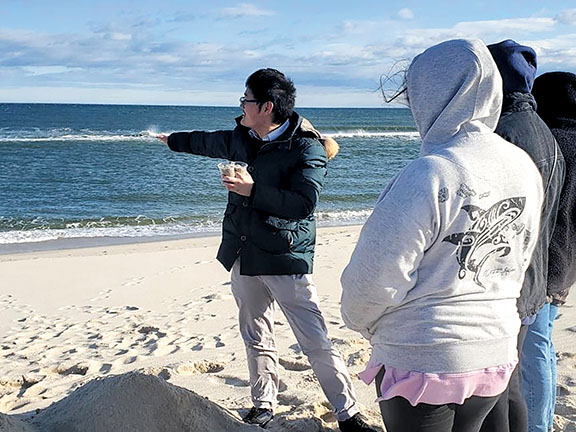
By Chris Rotolo
KEYPORT – A new team of Kean University researchers believes measurements of sand movements, wave energy and the shoreline itself in the Borough of Keyport can provide crucial data to combat the effects of climate change on the greater Bayshore community.
The adoption of a resolution in December paved the way for a partnership with the Union County university, which allows for researchers to conduct measurements along the Keyport waterfront that will gauge the greater impact of a forthcoming sand replenishment project in neighboring Union Beach.
“This is a community that suffered heavy damage from (Super Storm Sandy), but also suffers from sunny day (nuisance) flooding,” said Jun Cheng, a coastal geologist and assistant professor at the university who is leading the Kean team.
Cheng told The Two River Times that Keyport is particularly susceptible to vicious northeasterly winds due to its position in the Raritan Bay. The town’s narrow beaches leave it open to potentially devastating storm surges that can encroach on homes and businesses.
According to data presented by the United States Environmental Protection Agency (EPA) on climate change effects in New Jersey, annual rainfall and other precipitation has increased between 5 and 10% since approximately 1916. Additionally, since 1958, the EPA said precipitation related to “extremely heavy storms” has increased approximately 70%. As for the next century, the EPA anticipates “the frequency of heavy downpours is likely to keep rising.”
Areas of Union Beach, the Port Monmouth section of Middletown near Compton Creek, and the lower scenic section of the Borough of Highlands are just a handful of Bayshore communities regularly impacted by nuisance flooding and stormwater runoff.
According to Cheng, “wider beachfront areas can help reduce wave energy” and literally help keep damaging surges at bay.
Though the devastating impact of Super Storm Sandy was felt as far south as Atlantic City, Sandy’s surge reached its peak in the Garden State at nearby Sandy Hook, where flood waters climbed to a height of 8.57 feet, according to the National Weather Service.
In Sea Bright, waters from the Atlantic Ocean and Shrewsbury River converged along Ocean Avenue, while just north in Atlantic Highlands vessels were lifted out of the harbor and carried up First Avenue before settling at the intersection of State Route 35. In Union Beach approximately 85% – or 1,705 homes – were damaged by the storm, according to New Jersey Department of Community Affairs figures.
A coastal vulnerability study commissioned by Keyport said the borough sustained nearly $6 million in damages to 113 properties during Sandy due to high winds and flood waters that reached 6.7 feet in height.
“(Super Storm Sandy) was a once-in-a-lifetime storm, but there is no questioning the vulnerability of the Bayshore to weather events like hurricanes and nor’easters. The flooding and the erosion they cause can be devastating to communities that are unable to address those issues,” Cheng added. “I believe the work we do in Keyport can be valuable to other coastal communities, but right now we need to focus on our efforts to help this community.” Cheng hopes his team’s efforts will arm Keyport with data that can bolster the borough’s requests to the Army Corps of Engineers for further beach replenishment initiatives.
“We are working to help generate an understanding of the effects of urban development and climate change on coastal environments and on the communities that rely on the shore as their home and for their livelihood,” said Daniela Shebitz, chair of Kean University’s Department of Environmental and Sustainability Sciences, which is overseeing the research study.
Cheng and Shebitz will be joined in Keyport by Kean assistant professor and water quality expert Shuting Liu, and post-doctoral fellow Galia Shokry, an environmental justice specialist. Shalini Katwal, a junior earth science major at the university, will also be on site contributing to the study.
Initial measurements and testing are expected to begin this week.
The article originally appeared in the February 23 – March 1, 2023 print edition of The Two River Times.














